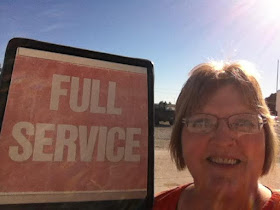I admit it: I'll be scrolling along on Facebook, and I'll get momentarily distracted by a cooking video. Sometimes, my distraction turns into printing the recipe and actually making it. (Jill would point out that I don't actually have to print the recipe. I could just pull it up on my phone. But I'm a paper recipe kind of gal.)
Slowing my Facebook scroll was the case for this Slow Cooker Loaded Baked Potato Soup. A couple of different Facebook friends shared it, and I was cold enough that soup sounded good. Plus, a slow cooker soup is always a bonus because I can fix it and go about my day. Several hours later, I've got dinner made by adding just a few extras ... in this case, crackers and baby carrots.
The original recipe didn't have the additional vegetables, so I made some adjustments, adding carrots, celery and onions. (I guess I'm getting all "fancy" with my cooking channel "mirepoix.")
I've made this soup a couple of times this winter. One time was when Kinley and Brooke were here, and they both loved it, too. It gets a thumbs up from the younger set and a bonafide Kansas farmer. It's delicious the first time around, and the leftovers warm up well.
As I looked at the Facebook recipe, there were people complaining about the use of frozen hash browns and commenting about using "fresh" potatoes. Yes, you could cut your own potatoes into cubes, and it would be less expensive. (Though it wouldn't be as convenient.) So, by all means, if you want to peel and dice non-frozen potatoes, go for it!
But, just for the record, frozen potatoes are "real" potatoes, too. (It seems we have to have reminders like that with the current "organic" and "natural" obsession.
This recipe is perfect for the cold weather we're getting again this week. And the weather map shows snow coming again on Sunday. Here's your antidote! Enjoy!
I've made this soup a couple of times this winter. One time was when Kinley and Brooke were here, and they both loved it, too. It gets a thumbs up from the younger set and a bonafide Kansas farmer. It's delicious the first time around, and the leftovers warm up well.
As I looked at the Facebook recipe, there were people complaining about the use of frozen hash browns and commenting about using "fresh" potatoes. Yes, you could cut your own potatoes into cubes, and it would be less expensive. (Though it wouldn't be as convenient.) So, by all means, if you want to peel and dice non-frozen potatoes, go for it!
But, just for the record, frozen potatoes are "real" potatoes, too. (It seems we have to have reminders like that with the current "organic" and "natural" obsession.
This recipe is perfect for the cold weather we're getting again this week. And the weather map shows snow coming again on Sunday. Here's your antidote! Enjoy!
Slow Cooker Loaded Baked Potato Soup
Adapted from Facebook
1 bag (32 oz.) frozen hash brown potato cubes3/4 cup chopped carrots
1/2 cup chopped celery
1/4 cup chopped onion
1 box (32 oz.) chicken broth (or water and bouillon to make 32 ounces)
1 can (10 oz.) cream of chicken soup, undiluted
1 1/2 cups grated sharp Cheddar cheese
1 pkg. (8 oz.) cream cheese
3/4 cup crumbled bacon (plus extra for garnish, if desired)
1/2 tsp. fresh rosemary (or 1/4 tsp. dried)
Freshly ground pepper, to taste
Salt, to taste (I used bouillon, and I didn't add any salt)
Combine hash brown potatoes, vegetables, chicken broth, cream of chicken soup, Cheddar cheese, cream cheese, bacon and seasonings. Mix to break up cream cheese, though it won't be totally incorporated at this time. Place lid on slow cooker and cook on High for 3 hours, stirring occasionally to continue to incorporate cheese and cream cheese, until potatoes and vegetables are tender. (It may take a little longer than 3 hours to get the extra veggies tender. If you want to make sure the veggies are tender quickly, microwave the carrots, celery and onion in a microwave-safe bowl or measuring cup until they are par-tender. You don't need to add water. Just cover with plastic wrap and microwave. They don't need to be soft. They will cook more in the soup.) Taste and adjust seasonings. Garnish with additional bacon bits, cheese and/or chopped green onion or cilantro and serve with crackers and additional raw veggies.
If available, you can use southern-style hash browns, which have some onions and green peppers already incorporated. I still like adding the bonus veggies.
Note: Use crock pot liners for easier clean up.
Serves 6.



























































